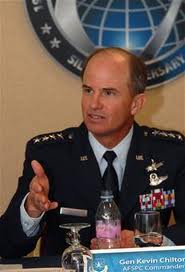Air Force Magazine: Ratify New START to End Uncertainty
October 21, 2010
Featured Image
Today's top nuclear policy stories, with excerpts in bullet form.
Stories we're following today: Thursday October 21, 2010.
Arms Control, On a Schedule - Adam J. Hebert in Air Force Magazine [link]
- But after 21 years of on-site inspections, no US nuclear inspectors have had access to Russian nuclear facilities in nearly a year. Over time, this lack of knowledge could force the US into "worst case" planning assumptions about Russia’s strategic forces and its capabilities and intent. That is not in America’s best interest.
- New START is far superior to the uncertainty and guesswork that accompany no agreement whatsoever.
- The Senate this fall will debate whether to ratify New START, which would restore US access to Russian nuclear sites. President Obama and Russian President Dmitry Medvedev signed New START in April, and the Senate Foreign Relations Committee passed it by a 14-to-four vote in September. The next step is a full Senate vote.
- New START critics implore Senators not to rush to judgment or "rubber stamp" the treaty. The fact that the Administration has formally answered more than 900 questions from a Senate that has held more than 20 hearings should allay any concerns that legislators are rubber-stamping this treaty.
North Korea Movements at Nuclear Site Spark Speculation of Test - Bomi Lim and Shinhye Kang for Bloomberg [link]
- A U.S. reconnaissance satellite has detected movements at Punggyeri in North Korea’s northeastern North Hamgyong Province that may be related to preparations for a third nuclear test, Chosun Ilbo newspaper reported today, citing a South Korean government official it didn’t identify.
- South Korea’s military is carefully monitoring the site, where activities have commonly been detected, a defense ministry official said in Seoul on condition of anonymity according to ministry policy.
- North Korea conducted its second nuclear test in May 2009 after the first blast in October 2006, prompting the United Nations Security Council to toughen sanctions. The country may be seeking to showcase bolstered military capability to rally support for Kim’s youngest son and heir-apparent, Kim Jong Un, Chosun said.
- The speculation of North Korea’s nuclear test comes as South Korea is preparing for the Group of 20 leaders’ summit in Seoul next month. South Korea has said the nation is on alert for possible North Korean provocations including explosions at “major facilities,” suicide bombings, chemical assaults or cyber attacks during the Nov. 11-12 meetings.
U.S. Advances Saudi F-15 Package - Adam Entous in The Wall Street Journal [link]
- The Obama administration notified Congress it plans to sell Saudi Arabia up to $60 billion in advanced military aircraft, including F-15s equipped with bunker-buster bombs that Washington sees as part of an effort to contain Iran.
- The inclusion of [bunker-buster bombs] would enhance the capability of Saudi Arabia's air force to bomb hardened bunkers and tunnels, such as those that the West believes are used by Iran to hide nuclear and ballistic missile programs.
- The package, the largest overseas U.S. arms deal to date, "supports our wider regional security goals in the Gulf" without undercutting ally Israel's military edge, Assistant Secretary of State for Political-Military Affairs Andrew Shapiro said.
- Boeing Co., which makes the F-15s and the Apaches, says the Saudi package would directly or indirectly support 77,000 jobs across 44 states, according to U.S. officials.
Not a DAFy Idea - Nick Roth on All Things Nuclear a Union of Concerned Scientists Blog [link]
- Last month, the Project on Government Oversight (POGO) released a report titled, “U.S. Nuclear Weapons Complex: How the Country Can Profit and Become More Secure by Getting Rid of Its Surplus Weapons-Grade Uranium.” The last section of the report makes recommendations on how to accelerate the rate at which the U.S. dismantles nuclear warheads.
- POGO argues that using the Device Assembly Facility (DAF) at the Nevada National Security Site (formerly known as the Nevada Test Site) could increase dismantlement rates.
- The bays and cells at the DAF are the same bays and cells used at the Pantex Plant (the only current location where warheads are dismantled) for assembling and disassembling warheads...Logically, if the DAF can be used to assemble a warhead, it can most likely also be used for disassembly.
- A 2002 Arms Control Today article argued that, with its five warhead assembly cells and seven bays, the DAF could potentially have 20% of the capacity of the Pantex facility.
- The possibility of using this existing facility makes sense and should be investigated. The administration or congress should call for an independent review of its utility, environmental and health impacts, required modifications, and costs.
Iran Has 30kg of High Level Uranium: Atomic Chief - AFP [link]
- Iran said on Wednesday it has produced around 30 kilogrammes of 20 percent-enriched uranium, in defiance of UN sanctions imposed on Tehran to suspend the contentious nuclear work.
- World powers led by Washington want Tehran to suspend its uranium enrichment activity, which is at the centre of fears that Iran is developing a nuclear weapons.
- President Mahmoud Ahmadinejad ordered Iran's atomic body in February to start refining uranium to 20 percent after a nuclear fuel swap deal drafted by the UN atomic watchdog and aimed at providing fuel for a Tehran research reactor hit a deadlock.
- Iran claims that by September 2011 it will domestically produce the required fuel and the actual fuel plates to power the reactor.
- Meanwhile, Iran and the group of six world powers -- Britain, China, France, Germany, Russia and the United States -- are to hold talks on Tehran's overall nuclear programme in mid-November.



